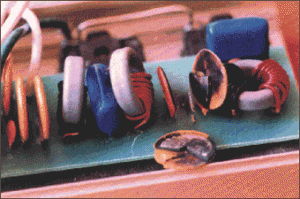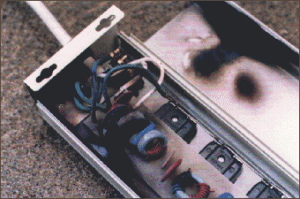The heart of many surge protectors available today is a small electronic component called a metal oxide varistor (MOV). The role of the MOV is to divert surge current, however, MOVs wear out with use. As more surges are diverted, the MOV’s life span shortens, and failure becomes imminent. How soon? How many surges can they handle? No one knows until failure occurs! There is no forewarning or visual indications given – just failure. And while failing, they can reach very high temperatures, and actually start fires. See examples of catastrophic MOV failures in the photos below.

This MOV (the yellow disks) fractured cleanly. Surge protection is lost, and the “protected” computer was severely damaged, but there is no fire danger. This unit continues to deliver power, and all lights and switches operate without any indication of failure.
This model is an example of dangerous construction, where failed MOV is packed too tightly between adjacent components and cannot split open. This unit is still a live short circuit and sparks violently when plugged into a live receptacle.


Circuit board removed from plastic case, showing all 6 MOVs (yellow disks). One leg of each MOV has been cut and there is therefore no protection, but “Protection Working” LED continues to glow green.
All 6 MOVs removed from circuit board, but “Protection Working” LED (immediately above large yellow capacitor) remains lit.

Industry experts estimate surge probabilities in terms of thousands of surge occurrences. What do MOV manufacturers publish regarding their product’s surge capability? This table shows three manufacturer’s surge ratings for two popular sizes of MOVs used in surge suppressors.
Metal-Oxide Varistor Endurance Ratings
| Size / Name of Manufacturer | Panasonic | Siemens | Harris Semiconductor |
| 14 mm MOV | 10 surges at 1000 amps | 10 surges at 1000 amps | 10 surges at 1000 amps |
| 20 mm MOV | 100 surges at 1000 amps | 100 surges at 1000 amps | 100 surges at 1000 amps |
